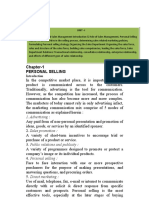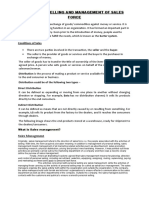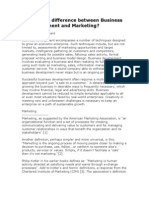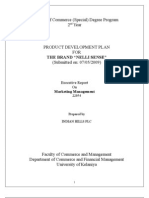Sales Methods: Selling
Sales Methods: Selling
Uploaded by
LakshanmayaCopyright:
Available Formats
Sales Methods: Selling
Sales Methods: Selling
Uploaded by
LakshanmayaOriginal Description:
Original Title
Copyright
Available Formats
Share this document
Did you find this document useful?
Is this content inappropriate?
Copyright:
Available Formats
Sales Methods: Selling
Sales Methods: Selling
Uploaded by
LakshanmayaCopyright:
Available Formats
A sale is the act of selling a product or service in return for money or other
compensation.
[1]
Signalling completion of the prospective stage, it is the beginning of an engagement
between customer and vendor or the extension of that engagement.
The seller or salesperson the provider of the goods or services completes a sale in response to
an acquisition or to anappropriation
[2]
or to a request. There follows the passing of title (property or
ownership) in the item, and the application and due settlement of a price, the obligation for which
arises due to the seller's requirement to pass ownership. Ideally, a seller agrees upon a price at
which he willingly parts with ownership of or any claim upon the item. The purchaser, though a party
to the sale, does not execute the sale, only the seller does that. To be precise the sale completes
prior to the payment and gives rise to the obligation of payment. If the seller completes the first two
above stages (consent and passing ownership) of the sale prior to settlement of the price, the sale
remains valid and gives rise to an obligation to pay.
Contents
[hide]
1 Sales methods
2 Sales agents
o 2.1 Inside sales vs. Outside sales
3 The relationships between sales and marketing
o 3.1 Industrial marketing
4 Sales and marketing alignment and integration
5 See also
6 References
Sales methods[edit]
A beach salesman showing necklaces to a tourist in Mexico.
A sale can take place through:
[3]
Direct sales, involving person to person contact
Pro forma sales
Agency-based
Sales agents (for example in real estate or in manufacturing)
Sales outsourcing through direct branded representation
Transaction sales
Consultative sales
Complex sales
Consignment
Telemarketing or telesales
Retail or consumer
Traveling salesman
Door-to-door methods
hawking
Request for proposal An invitation for suppliers, through a bidding process, to submit a
proposal on a specific product or service. An RFP usually represents part of a complex sales
process, also known as "enterprise sales".
Business-to-business Business-to-business ("B2B") sales are much more relationship-based
owing to the lack of emotional attachment
[citation needed]
to the products in question.
Industrial/professional sales involves selling from one business to another
Electronic
Web Business-to-business ("B2B") and business-to-consumer ("B2C")
Electronic Data Interchange (EDI) A set of standard for structuring information to be
electronically exchanged between and within businesses
Indirect, human-mediated but with indirect contact
Mail-order
vending machine
Sales Techniques:
Selling technique
Consultative selling
Sales enablement
Solution selling
Conceptual selling
Strategic selling
Transactional selling
Sales Negotiation
Reverse Selling
Upselling
Cross-selling
Paint-the-Picture
take away
Sales Habits
Relationship Selling
Sales agents[edit]
Agents in the sales process can represent either of two parties in the sales process; for example:
1. Sales broker, Seller agency, seller agent, seller representative: This is a traditional role
where the salesman represents a person or company on the selling end of a deal.
2. Buyers broker or Buyer brokerage: This is where the salesman represents the consumer
making the purchase. This is most often applied in large transactions.
3. Disclosed dual agent:This is where the salesman represents both parties in the sale and acts
as a mediator for the transaction. The role of the salesman here is to oversee that both
parties receive an honest and fair deal, and is responsible to both.
4. Transaction broker: This is where the salesperson represents neither party but handles the
transaction only. The seller owes no responsibility to either party getting a fair or honest
deal, just that all of the papers are handled properly.
5. Sales outsourcing involves direct branded representation where the sales representatives
are recruited, hired, and managed by an external entity but hold quotas, represent
themselves as the brand of the client, and report all activities (through their own sales
management channels) back to the client. It is akin to a virtual extension of a sales force
(see sales outsourcing).
6. Sales managers aim to implement various sales strategies and management techniques in
order to facilitate improved profits and increased sales volume. They are also responsible for
coordinating the sales and marketing department as well as oversight concerning
the fair and honest execution of the sales process by their agents.
7. Salesperson: The primary function of professional sales is to generate and close leads,
educate prospects, fill needs and satisfy wants of consumers appropriately, and therefore
turn prospective customers into actual ones. Questioning to understand a customer's goal
and requirements relevant to the product and the creation of a valuable solution by
communicating the necessary information that encourages a buyer to achieve their goal at
an economic cost comprise the functions of the salesperson or of the sales engine (for
example, the Internet, a vending machine, etc.). A good salesperson should never mis-sell
or over-evaluate the customer's requirements.
Inside sales vs. Outside sales[edit]
Since the advent of the telephone, a distinction has been made
[4]
between "inside sales" and "outside
sales" although it is generally agreed that those terms have no hard-and-fast definition.
[5]
In the
United States, the Fair Labor Standards Act defines outside sales representatives as "employees
[who] sell their employer's products, services, or facilities to customers away from their employer's
place(s) of business, in general, either at the customer's place of business or by selling door-to-door
at the customer's home" while defining those who work "from the employer's location" as inside
sales.
[6]
Inside sales generally involves attempting to close business primarily over the phone
via telemarketing, while outside sales (or "field" sales) will usually involve initial phone work to book
sales calls at the potential buyer's location to attempt to close the deal in person. Some companies
have an inside sales department that works with outside representatives and book their
appointments for them. Inside sales sometimes refers to upselling to existing customers.
The relationships between sales and marketing[edit]
Marketing and sales differ greatly, but have the same goal. Selling is the final stage in Marketing,
which also includes Pricing, Promotion, Positioning and Product (the 4 P's). A marketing department
in an organization has the goals of increasing the desirability and value to the customer and
increasing the number and engagement of interactions between potential customers and the
organization. Achieving this goal may involve the sales team using promotional techniques such
as advertising,sales promotion, publicity, and public relations, creating new sales channels, or
creating new products (new product development), among other things. It can also include bringing
the potential customer to visit the organization's website(s) for more information, or to contact the
organization for more information, or to interact with the organization via social media such
as Twitter, Facebook and blogs.
The field of sales process engineering views "sales" as the output of a larger system, not just as the
output of one department. The larger system includes many functional areas within an organization.
From this perspective, "sales" and "marketing" (among others, such as "customer service") label for
a number of processes whose inputs and outputs supply one another to varying degrees. In this
context, improving an "output" (such as sales) involves studying and improving the broader sales
process, as in any system, since the component functional areas interact and are interdependent.
[7]
Most large corporations structure their marketing departments in a similar fashion to sales
departments
[citation needed]
and the managers of these teams must coordinate efforts in order to drive
profits and business success. For example, an "inbound" focused campaign seeks to drive more
customers "through the door", giving the sales department a better chance of selling their product to
the consumer. A good marketing program would address any potential downsides as well.
The sales department would aim to improve the interaction between the customer and the sales
facility or mechanism (example, web site) and/or salesperson. Sales management would break
down the selling process and then increase the effectiveness of the discrete processes as well as
the interaction between processes. For example, in many out-bound sales environments, the typical
process includes out-bound calling, the sales pitch, handling objections, opportunity identification,
and the close. Each step of the process has sales-related issues, skills, and training needs, as well
as marketing solutions to improve each discrete step, as well as the whole process.
One further common complication of marketing involves the inability to measure results for a great
deal of marketing initiatives. In essence, many marketing and advertising executives often lose sight
of the objective of sales/revenue/profit, as they focus on establishing a creative/innovative program,
without concern for thetop or bottom lines - a fundamental pitfall of marketing for marketing's sake.
Many companies find it challenging to get marketing and sales on the same page.
[8]
The two
departments, although different in nature, handle very similar concepts and have to work together for
sales to be successful. Building a good relationship between the two that encourages
communication can be the key to success - even in a down economy.
[9]
Industrial marketing[edit]
The idea that marketing can potentially eliminate the need for sales people depends entirely on
context. For example, this may be possible in some B2C situations; however, for
many B2B transactions (for example, those involving industrial organizations) this is mostly
impossible.
[citation needed]
Another dimension is the value of the goods being sold. Fast-moving consumer-
goods (FMCG) require no sales people at the point of sale to get them to jump off the supermarket
shelf and into the customer's trolley. However, the purchase of large mining equipment worth
millions of dollars will require a sales person to manage the sales process - particularly in the face of
competitors. Small and medium businesses selling such large ticket items to a geographically-
disperse client base use Manufacturers' representatives to provide these highly personal service
while avoiding the large expense of a captive sales force.
Sales and marketing alignment and integration[edit]
Another area of discussion involves the need for alignment and integration between corporate sales
and marketing functions. According to a report from the Chief Marketing Officer (CMO) Council, only
40 percent of companies have formal programs, systems or processes in place to align and integrate
the two critical functions.
Traditionally, these two functions, as referenced above, have operated separately, left in siloed
areas of tactical responsibility. Glen Petersens book The Profit Maximization Paradox
[10]
sees the
changes in the competitive landscape between the 1950s and the time of writing as so dramatic that
the complexity of choice, price and opportunities for the customer forced this seemingly simple and
integrated relationship between sales and marketing to change forever. Petersen goes on to
highlight that salespeople spend approximately 40 percent of their time preparing customer-facing
deliverables while leveraging less than 50 percent of the materials created by marketing, adding to
perceptions that marketing is out of touch with the customer and that sales is resistant
to messaging and strategy.
See also[edit]
Look up sale in
Wiktionary, the free
dictionary.
Buzzword
Choice architecture
Customer service
Demand chain
Manufacturers' representative
Point of sale
Retailing
Sales (accounting)
Sales effectiveness
Sales incentive plan
Sales contest
Sales process engineering
Sales management
Sales territory
Sales variance
Selling
Trade
Transaction
Vendor
VisitBasis
You might also like
- Personal Selling, Relationship Building and Sales Management - ENGDocument3 pagesPersonal Selling, Relationship Building and Sales Management - ENGAli Haroon100% (1)
- The SaaS Sales Method for Account Executives: How to Win Customers: Sales Blueprints, #5From EverandThe SaaS Sales Method for Account Executives: How to Win Customers: Sales Blueprints, #5No ratings yet
- MadhubalaDocument12 pagesMadhubalaLakshanmaya100% (3)
- Marketing Strategy of Micromaxx MbaDocument57 pagesMarketing Strategy of Micromaxx MbaPrints BindingsNo ratings yet
- About UnileverDocument26 pagesAbout UnileverzakirdecentNo ratings yet
- Sales and MarketingDocument6 pagesSales and MarketingDominic Kabuga MutugiNo ratings yet
- Sales AgentsDocument3 pagesSales AgentsDavidCruzNo ratings yet
- What Is SaleDocument9 pagesWhat Is SalesectortrackingNo ratings yet
- Definition of Sales: (Hide)Document6 pagesDefinition of Sales: (Hide)moonthinkerNo ratings yet
- Sales and Marketing Channel Management (M3) : Course ObjectiveDocument37 pagesSales and Marketing Channel Management (M3) : Course ObjectiveDhanek NathNo ratings yet
- Merger NotesDocument55 pagesMerger NotesRajeshwar PoteNo ratings yet
- Sales and Retail ManagementDocument33 pagesSales and Retail Managementsaumya tiwariNo ratings yet
- Zebronics SpeakerDocument56 pagesZebronics SpeakerApple ComputersNo ratings yet
- Development of Sales OrganizationDocument4 pagesDevelopment of Sales OrganizationFahad MohammedNo ratings yet
- As 110 NegotiationDocument7 pagesAs 110 NegotiationWameq SiddiquiNo ratings yet
- Personal Selling ArticleDocument7 pagesPersonal Selling Articlevarun168No ratings yet
- Complete Notes (SCM)Document187 pagesComplete Notes (SCM)Scroll with deepriyaNo ratings yet
- IM Chaptet 5Document21 pagesIM Chaptet 5john kibruNo ratings yet
- Unit-3 Sales Process PDFDocument12 pagesUnit-3 Sales Process PDFbhar4tpNo ratings yet
- SMBD Reflective NotesDocument5 pagesSMBD Reflective NotesShaz BhuwanNo ratings yet
- Personal SellingDocument16 pagesPersonal Sellingvinaycool12344150No ratings yet
- GCC&BA - SUPR - Personal Selling Public Relations Sales Promotion - Sushita Chakraborty - UG (R1)Document8 pagesGCC&BA - SUPR - Personal Selling Public Relations Sales Promotion - Sushita Chakraborty - UG (R1)lazelifestyleNo ratings yet
- Sales and Distribution Management 1Document30 pagesSales and Distribution Management 1Divyanshu PandeyNo ratings yet
- Chapter 5: Promotion Strategy in International Context: Types of Personal SellingDocument9 pagesChapter 5: Promotion Strategy in International Context: Types of Personal SellingLamesa DarajeNo ratings yet
- Chapter - 4 MineDocument23 pagesChapter - 4 MineBereket MinaleNo ratings yet
- 01 Coordinate Sales PerformanceDocument7 pages01 Coordinate Sales PerformanceSAMUALE ASSEFA MEKURIYA100% (1)
- Personal SellingDocument12 pagesPersonal SellingSachin NairNo ratings yet
- 3rd Sem SDMDocument72 pages3rd Sem SDMRocky BhaiNo ratings yet
- Session 2 Page 37-45 (Havaldar) Steps in The Selling ProcessDocument9 pagesSession 2 Page 37-45 (Havaldar) Steps in The Selling Processvaibhav chaurasiaNo ratings yet
- Sales QB SolvedDocument13 pagesSales QB Solved1185 Saptik GhoshNo ratings yet
- LESSON 1 Sales ManagementDocument6 pagesLESSON 1 Sales ManagementBagbara DanielNo ratings yet
- Sales Management: Bachelor of Business Administration (B.B.A.)Document202 pagesSales Management: Bachelor of Business Administration (B.B.A.)Shreya Saransh GoelNo ratings yet
- SK Nsut Personal Selling and Sales Promotion Ignou 37 SlidesDocument37 pagesSK Nsut Personal Selling and Sales Promotion Ignou 37 SlidesISHITANo ratings yet
- SM TutorialDocument38 pagesSM TutorialHAO WEN NYIAUNo ratings yet
- Marketing Is The Process of Communicating The Value of A Product or Service To CustomersDocument2 pagesMarketing Is The Process of Communicating The Value of A Product or Service To CustomersGaluhAyuMaharaniNo ratings yet
- Personal Selling LabDocument9 pagesPersonal Selling LabdexterNo ratings yet
- CH 1-INTRODUCTION TO INTEGRATED MARKETING COMMUNICATIONDocument19 pagesCH 1-INTRODUCTION TO INTEGRATED MARKETING COMMUNICATIONkirubel5110No ratings yet
- SDMDocument106 pagesSDMAnonymous x4mrSXNo ratings yet
- Order Financing: RelationshipDocument17 pagesOrder Financing: RelationshiplinNo ratings yet
- The Difference Between Sales and Marketing by Jim StovallDocument11 pagesThe Difference Between Sales and Marketing by Jim Stovallpandey_manishNo ratings yet
- Sales Department Relations: (Within The Marketing Function)Document24 pagesSales Department Relations: (Within The Marketing Function)Babul YumkhamNo ratings yet
- Developing Export Marketing PlanDocument23 pagesDeveloping Export Marketing PlanAmardeep BhogalNo ratings yet
- Study Material SDMDocument63 pagesStudy Material SDMnikkyagarwal13No ratings yet
- PersonalsellingDocument16 pagesPersonalsellingAdamZain788No ratings yet
- What Is The Difference Between Business Development and MarketingDocument3 pagesWhat Is The Difference Between Business Development and Marketingsunil_dawareNo ratings yet
- Sales and Marketing TerminologyDocument41 pagesSales and Marketing Terminologysumu26No ratings yet
- Chapter 1-INTRODUCTION TO SALES MANAGEMENTDocument7 pagesChapter 1-INTRODUCTION TO SALES MANAGEMENTLance Reyes AguilarNo ratings yet
- Report On Personal SellingDocument11 pagesReport On Personal SellingGirish Harsha100% (5)
- Selling NotesDocument12 pagesSelling NotesAshish PathakNo ratings yet
- 203 Unit III NotesDocument5 pages203 Unit III NotesGarv sethiNo ratings yet
- Criticism of Advertising Is Closely Linked WithDocument3 pagesCriticism of Advertising Is Closely Linked Withsiva prakashNo ratings yet
- Lesson 46 Personal SellingDocument5 pagesLesson 46 Personal SellingAjay SinghNo ratings yet
- Personal SellingDocument13 pagesPersonal SellingAbhiram P RNo ratings yet
- Personal Selling ProcessDocument28 pagesPersonal Selling ProcessGaurav Sethia100% (1)
- Sales & Distribution Management R HanjiDocument32 pagesSales & Distribution Management R HanjiManikanta ShaasthaNo ratings yet
- Sales NotesDocument41 pagesSales Notesdebashish.chikuNo ratings yet
- The Art of Sales: Techniques for Closing Deals and Driving RevenueFrom EverandThe Art of Sales: Techniques for Closing Deals and Driving RevenueNo ratings yet
- A Festival Is An Event Ordinarily Celebrated by A Community and Centering On Some Characteristic Aspect of That Community and Its Religion or CulturesDocument5 pagesA Festival Is An Event Ordinarily Celebrated by A Community and Centering On Some Characteristic Aspect of That Community and Its Religion or CulturesLakshanmayaNo ratings yet
- VapiDocument5 pagesVapiLakshanmayaNo ratings yet
- Concept: Marketing Is The Study andDocument13 pagesConcept: Marketing Is The Study andLakshanmayaNo ratings yet
- The Indian Premier LeagueDocument12 pagesThe Indian Premier LeagueLakshanmayaNo ratings yet
- Murikkady: Submerged Trees in Periyar National ParkDocument1 pageMurikkady: Submerged Trees in Periyar National ParkLakshanmayaNo ratings yet
- Logistics Is Generally The Detailed Organization and Implementation of A Complex Operation. in ADocument14 pagesLogistics Is Generally The Detailed Organization and Implementation of A Complex Operation. in ALakshanmayaNo ratings yet
- Terminology: Environmental Science Is AnDocument5 pagesTerminology: Environmental Science Is AnLakshanmayaNo ratings yet
- Baahubali Baahubali: The Beginning: Baahubali 2: The Conclusion, Also Known As BB2, Is An Indian BilingualDocument1 pageBaahubali Baahubali: The Beginning: Baahubali 2: The Conclusion, Also Known As BB2, Is An Indian BilingualLakshanmayaNo ratings yet
- Seven Sister States: Assam (Document14 pagesSeven Sister States: Assam (LakshanmayaNo ratings yet
- Concept: The HouseDocument2 pagesConcept: The HouseLakshanmayaNo ratings yet
- First Inhabitants: Andaman Cellular JailDocument5 pagesFirst Inhabitants: Andaman Cellular JailLakshanmayaNo ratings yet
- Bangalore: ListenDocument10 pagesBangalore: ListenLakshanmayaNo ratings yet
- Responsibilities and AuthoritiesDocument3 pagesResponsibilities and AuthoritiesLakshanmayaNo ratings yet
- Language Is The Ability To Acquire and Use Complex Systems ofDocument2 pagesLanguage Is The Ability To Acquire and Use Complex Systems ofLakshanmayaNo ratings yet
- Sunday Monday Thursday Saturday Sunday Monday Friday: Sakat ChauthDocument1 pageSunday Monday Thursday Saturday Sunday Monday Friday: Sakat ChauthLakshanmayaNo ratings yet
- The Tell-Tale Brain - V S RamachandranDocument46 pagesThe Tell-Tale Brain - V S RamachandranSiddharth RohillaNo ratings yet
- Case Study MTM-1aDocument45 pagesCase Study MTM-1aclickmateen0% (2)
- Transforming Customer Segmentation at Global BankDocument2 pagesTransforming Customer Segmentation at Global Bankshivansh.tandon998No ratings yet
- Lahore School of Economics: Faizan KhalidDocument9 pagesLahore School of Economics: Faizan KhalidMahnoor KhalidNo ratings yet
- QuizDocument12 pagesQuizNandish TalawarNo ratings yet
- Thesis CapsuleDocument5 pagesThesis CapsuleChristopher Luigi RodriguezNo ratings yet
- Omaxe LucknowDocument46 pagesOmaxe LucknowMehul TankNo ratings yet
- History of Indian Spices: C C C C C CDocument9 pagesHistory of Indian Spices: C C C C C CTanvi Rajde67% (3)
- MCR Assignment - Docx 2Document39 pagesMCR Assignment - Docx 2Austin EginongNo ratings yet
- PRODUCT DEVELOPMENT PLAN FOR THE BRAND "NELLI SENSE" (Assumption Only0Document21 pagesPRODUCT DEVELOPMENT PLAN FOR THE BRAND "NELLI SENSE" (Assumption Only0neelackshaNo ratings yet
- RSS 13 Field ExperienceDocument2 pagesRSS 13 Field ExperienceShailendra ReddyNo ratings yet
- Virgin Group Case StudyDocument2 pagesVirgin Group Case Studytej_doradoNo ratings yet
- Olive Lane Content StudioDocument7 pagesOlive Lane Content StudioolivelanecontentNo ratings yet
- Online Consumer Behavior - RM PDFDocument44 pagesOnline Consumer Behavior - RM PDFRasseerat KohliNo ratings yet
- Media and Information ManipulationDocument33 pagesMedia and Information ManipulationmarkNo ratings yet
- Alaska Milk Corporation PresentationDocument19 pagesAlaska Milk Corporation PresentationRonnie DeanNo ratings yet
- 期刊Document10 pages期刊phuong.hoangctvNo ratings yet
- Customerrelationshipmanagementcrminstarbucks1 12787759885727 Phpapp01Document15 pagesCustomerrelationshipmanagementcrminstarbucks1 12787759885727 Phpapp01Vipula RawteNo ratings yet
- The Effects of Advertising: Critical CartoonsDocument8 pagesThe Effects of Advertising: Critical CartoonsAhmad AbdNo ratings yet
- A Model of Fan Identification: Antecedents and Sponsorship OutcomesDocument20 pagesA Model of Fan Identification: Antecedents and Sponsorship Outcomesapi-61200414No ratings yet
- LINKSMIND Ready To Go Digital PlansDocument16 pagesLINKSMIND Ready To Go Digital Plansjyotirmoy mondalNo ratings yet
- Marketing StrategiesDocument36 pagesMarketing Strategiesjelena79100% (1)
- By Satish Kumar MDocument16 pagesBy Satish Kumar Msumathi psgcasNo ratings yet
- Brand Wise ReportDocument2 pagesBrand Wise ReportNiTesH GoyalNo ratings yet
- Compras - ProveedoresDocument158 pagesCompras - ProveedorestristhanNo ratings yet
- Analysis of Ife, Efe and QSPM Matrix On Business Development StrategyDocument11 pagesAnalysis of Ife, Efe and QSPM Matrix On Business Development StrategyAditya SurjawanNo ratings yet
- The Consulting Business: Importance of An Overall Alignment of Business StrategiesDocument15 pagesThe Consulting Business: Importance of An Overall Alignment of Business StrategiesArnab DuttaNo ratings yet
- LSMDocument3 pagesLSMashrayfmsNo ratings yet









































































































